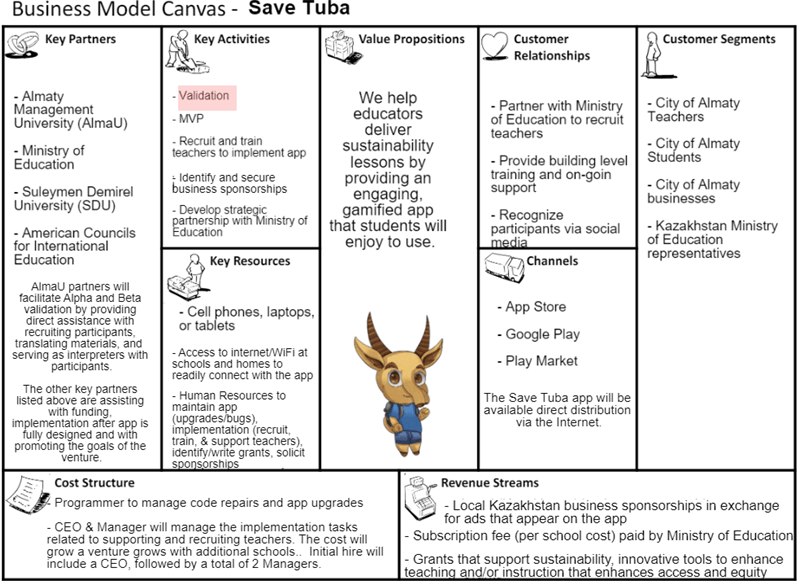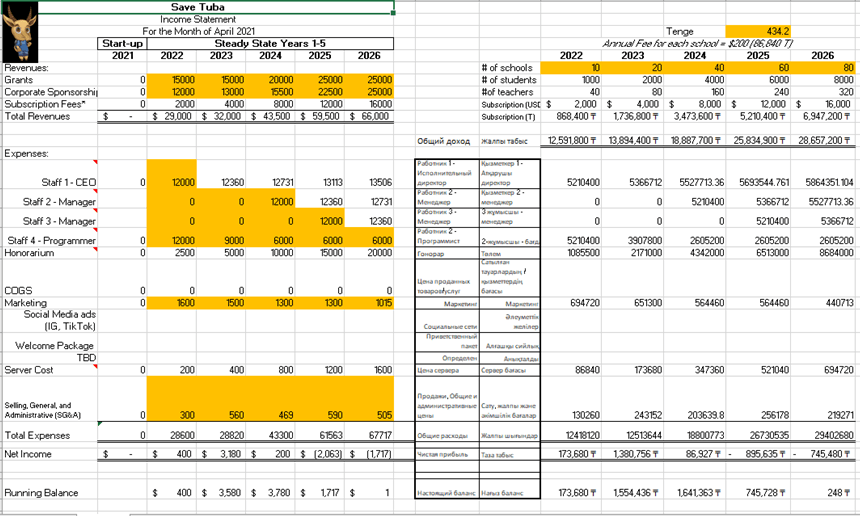Week 12: Update (II) Save Tuba Business Model Canvas & Revenue Model
Update II – Save Tuba Business Model Canvas (as of 04.25.21)

How will we deliver an end-to-end solution?
The Save Tuba app provides a comprehensive tool for teachers and students. Upon downloading the app, users will have all they need to navigate through the lessons and activities. The learning can be extended via engaging activities and real-life applications of the concepts learned. Students can take pictures with their device and easily integrate the evidence of their activity via the app. Teachers, also via the app, will have access to a dashboard that will provide information about the individual user’s status with the various activities, assessments, and general progress through the levels.
Update II – Save Tuba REALISTIC Revenue Model (as of 04.25.21)

Update II – Save Tuba OPTIMISTIC Revenue Model (as of 04.25.21)

Update II – Save Tuba PESSIMISTIC Revenue Model (as of 04.25.21)

Ten practical lessons from the business (revenue) models of ventures we reviewed in class or researched as they relate to our venture.
- Look into multiple sources of revenue stream to make the app more affordable for institutions. Along with subscriptions, getting sponsored by companies who are trying to create an image of being green would help both parties.
- Personalize the app to its region. Creating a targeted app will make the app more compelling for school administrators and school-aged children will find it engaging and relatable to complete the tasks. But most importantly, we can tap into local businesses who would be willing to invest into our project so that the tasks inside the app also have a connection to the local business. Thus, increasing the probability for sponsorships.
- Incentivizing a few teachers in each school to become the apps ambassador in their respective institution will help create a foothold for our project and will help us train new teachers quickly and efficiently.
- Host special weekly or seasonal in app events which will have tasks that give certain sponsored companies exposure. We should however maintain the apps ethics and integrity while choosing which companies can be a part of our program.
- We made a store for our character “Tuba” where students can buy shirts and hats in exchange for coins they collect by completing levels. We can have sponsored merchandise in store which can be given out during special events or can be exchanged using coins.
- It’s important for us to keep in mind that we didn’t draft our current business model for the sole purpose of completing a class assignment (i.e., it will serve as the foundation of our venture and we need to keep adding to it over time). For example, the revenue and costs as they relate to the students and teachers in Kazakhstan are not set in stone yet, since at this stage of our venture we are not sure how many schools we are going to be reaching out to. Once we develop a clearer idea, we are going to have to revise our business model.
- To add to the previous point of how our business model isn’t just a one-time assignment, we need to work on our revenue-generation plan over a longer period of time to make sure that it is as realistic as possible.
- What makes our current BM really strong is its simplicity, in that anyone could take a look at it and immediately figure out how our venture operates, how we are going to be generating revenue and staffing the venture, etc. It would be great if we could keep this up when adding to our BM in the future.
- Our team needs to do more research on the educational app market (e.g. determine who our main competitors are). This would prove to be especially beneficial for those of us who are working on developing the app, be it in terms of gaining inspiration from other successful ventures (looking at what they’re doing right and implementing it) or taking note of whether their technology is more advanced than ours/what we can do to make sure that we are on par so as to stay in business.
- Lowering costs would boost our revenue. While we’re trying not to be stingy with the money that we’re paying the venture’s management team, we need to work on reducing our marketing, server and SG&A costs as much as possible.